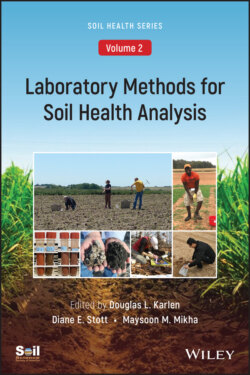Читать книгу Laboratory Methods for Soil Health Analysis, Volume 2 - Группа авторов - Страница 25
Judgement Sampling
ОглавлениеJudgement sampling selects sites presumed to represent larger areas (Table 2.3). Since site selection is based on the evaluator’s knowledge and skill, it is subject to considerable bias. As outcomes are inherent to the evaluator, application of this design for long‐term use is limited as changes in evaluator judgement are possible over time. Data collected using judgement sampling has limited statistical validity especially when isolated from other sites sampled by the same evaluator.
Despite its drawbacks, judgement sampling can be useful when resources are scarce and demands for accuracy and statistical rigor are relaxed. This design may also be applicable when samples are difficult to collect, or an evaluation involves attributes with high analytical cost.
Table 2.3 Definitions and attributes of different soil sampling designs.
| Description | Advantages | Disadvantages | Potential application |
|---|---|---|---|
| Judgement sampling | |||
| An approach to sampling that bases site selection on the knowledge and skill of the evaluator. Effective use of approach requires prior knowledge of site and attributes being assessed. Sites are generally selected to avoid nonrepresentative locations with the larger area. | Uses expert knowledge of site.Sampling decisions informed by previous experience.Limited sampling can save time and resources. | High degree of evaluator bias. Outcomes strongly associated with the individual doing site selection.Samplings over time are compromised by changes in evaluator judgement.Limited application to statistical analyses.Less legally defensible. | Initial site screening when resources for sampling and analyses are limited and demands for accuracy and statistical rigor are relaxed.In some instances, this approach may be useful for the evaluation of very expensive attributes when only a restricted number of samples can be collected. |
| Simple random sampling | |||
| A sampling approach whereby each sample collected has an equal chance of being selected. If used, prior knowledge of site is not required. | Approach minimizes bias associated with site selection.Relatively easy to apply.Approach is statistically valid. | Approach treats all points as equally important regardless of inherent and/or management‐induced stratification.Sampling locations may not adequately represent entire site (e.g., clustered sampling locations limit information on spatial distribution). | Approach is useful when knowledge of the site is limited.Collected data may be amenable to modeling applications (e.g., sensitivity analysis). |
| Stratified random sampling | |||
| An approach that uses random sampling within unique subareas to characterize a site. Prior knowledge of site stratification is helpful for identification of subareas. | Acknowledges intra‐site differences in inherent soil and/or management attributes. Accordingly, there is increased sensitivity to site nuances.Approach may increase sampling efficiency.Allows for understanding of presumed sources of site variability. | Approach requires prior knowledge of site attributes.Requires a more complex data analysis.Delineation of site by stratified attribute can differ among evaluators.Approach may generate many samples, requiring more resources. | Useful at sites with apparent soil, landscape, management, and/or contamination zones. |
| Systematic sampling | |||
| An approach to sampling whereby an entire area is sampled at predetermined points, usually in a grid‐like pattern. If used, prior knowledge of site is not required. | Application of sampling approach is generally straightforward.Can return to the same location for future samplings with confidence.Approach allows for use of geostatistical data analyses. | Selection of grid size can bias outcomes.Limited application of evaluator judgement.Approach may sacrifice sampling efficiency for the sake of following an established pattern.Depending on site, approach may be less cost effective than others. | Useful for soil mapping purposes when knowledge of site is limited.Appropriate in situations where the variable of interest is not expensive to collect and analyze.Collected data may be amenable to modeling applications (e.g., sensitivity analysis). |
